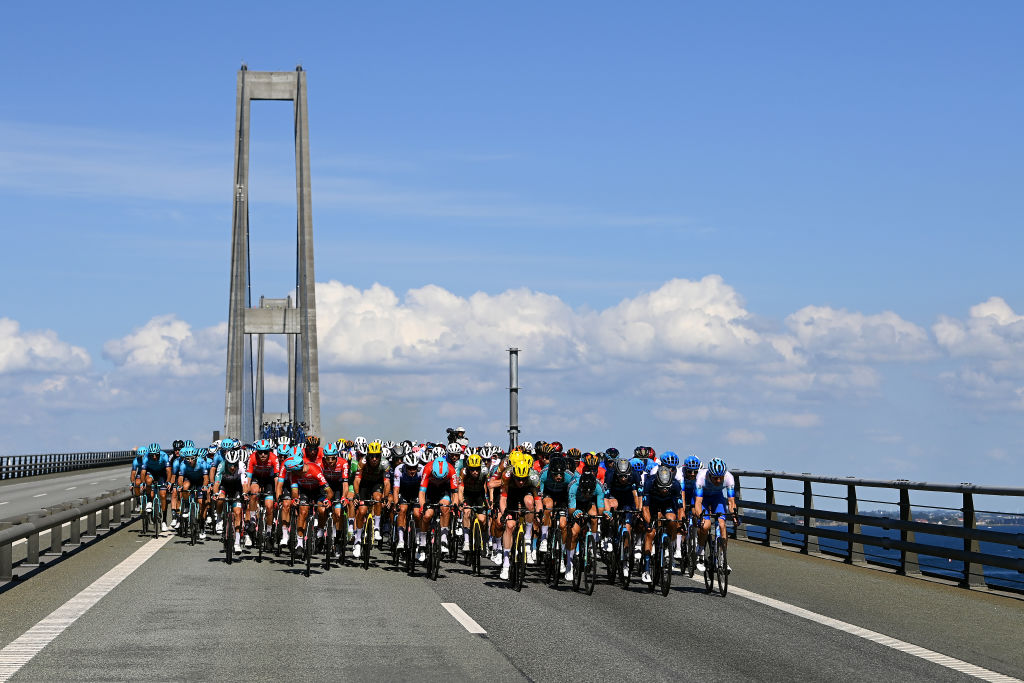Explainer: Why there were no echelon attacks on stage 2 of the Tour de France
'The head wind was so strong that it felt like a training ride' says van Aert

Everyone was expecting attacks, predicting echelon in the crosswinds, and crashes and carnage on the 18km long Great Belt Bridge.
The crashes came twice, at the start and the end of the Great Belt Bridge, but nobody was hurt and none of the overall contenders lost time.
Stage 2 of the Tour de France was calm rather than chaotic. And all for one simple reason: the wind blew but not in the right direction on the Great Belt Bridge to cause chaos.
There was a cross/head wind on the first part of the bridge and then a 35km/h block headwind on the second bridge, making earlier attacks futile, late attacks impossible and the slow pace into the wind helping anyone who was forced to chase from behind amongst the team cars.
“It was a full head wind, it’d be suicide to attack. Why attack before and go into a 20km head wind?” Mads Pedersen told Cyclingnews, bluntly explaining the day’s racing.
Yet before the start of the stage in Roskilde, there was tension in the air.
There was concern amongst even the most experienced directeur sportif that the riders would be unable to hold themselves back and protect each other, such was the desire and hunger to try to attack in the wind and win the first road stage of the Tour de France. Stakes were high and everyone was hungry for success.
Get The Leadout Newsletter
The latest race content, interviews, features, reviews and expert buying guides, direct to your inbox!
Fortunately, with road captains such as Luke Rowe (Ineos Grenadiers) and Philippe Gilbert (Lotto Soudal) marshalling the peloton after the neutralised roll out. An early break was allowed to go clear and the peloton opted not to take risks as Magnus Cort (EF Education-EasyPost) went on to gobble up the mountain points to later take the polka-dot jersey.
Kort and Sven Erik Bystrøm (Intermarche-Wanty-Gobert) soon distanced B&B Hotels pair Pierre Rolland and Cyril Barthe and pressed on and the peloton let them hang out front, knowing that with the sprinters’ teams in total charge.
The speed and then tension naturally picked-up before the Great Belt Bridge and Bystrøm was last to be caught but the only fear was a touch of wheels.
The first came with 21km to go saw a number of riders go down but most of the peloton raced on and race lead Yves Lampaert was quickly back in the peloton and escorted to the front by his QuickStep-AlphaVinyl teammates.
Rigoberto Urán (EF Education-EasyPost) was the only team leader to go down and lose contact but he quickly began to chase and soon had help from three teammates.
They and other chasers were a minute down on the peloton with 12km to go but the peloton eased dramatically into the headwind, climbing to the peak of the first bridge section relaxed and protected from the wind on the wheels, some even able to chat and enjoy the views across the Grand Belt sea.
“To be honest it was boring,” Wout van Aert said honestly of the bridge crossing after he avoided the crashes to finish second and so take the leader’s yellow jersey from Lampaert.
“The head wind was so strong that after 180km of race pace, it felt like a training ride. I think we rode at 30km/h on the uphill part.”
Uran and his teammates had to go somewhat harder to close the gap but they managed to get back on with 8.5km to go, relieved to not have lost time. The headwind saved their day.
The second crash with 2.5km was bigger, with more riders going down and many others being blocked but again there was panic. Tadej Pogačar was caught in the crash, as was Filippo Ganna and Dani Martinez of Ineos Grenadiers, and a number others.
However, it happened inside the final three kilometres and so all the riders would be awarded the same as the peloton they were in at the time.169 riders were all awarded the same time as stage winner Fabio Jakobsen (QuickStep-AlphaVinyl).
Pogačar laughed about suffering a grazed knuckle and the race medical bulletin was brief.
There was a sigh of relief in the peloton after everyone made it safely to the finish, all safe to live to fight for another day on the Tour de France. The wind had been predicted to cause chaos, in the end it enforced calm.

Stephen is one of the most experienced member of the Cyclingnews team, having reported on professional cycling since 1994. He has been Head of News at Cyclingnews since 2022, before which he held the position of European editor since 2012 and previously worked for Reuters, Shift Active Media, and CyclingWeekly, among other publications.